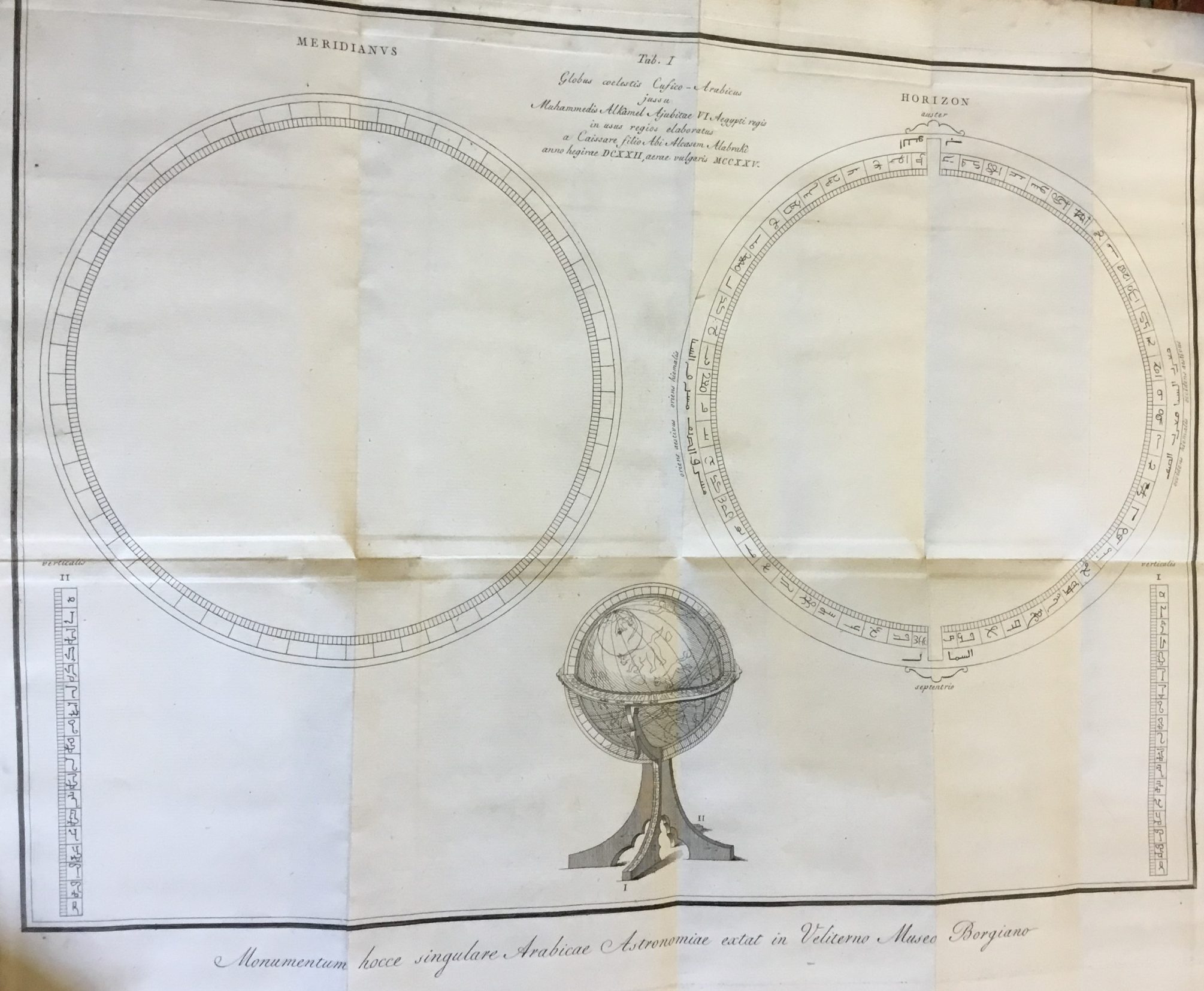Globus Caelestis Cufico-Arabicus Veliterni Musei Borgiani, a Simone Assemano illustratus; praemissa ejusdem de Arabum astronomia dissertatione, et adjectis duabus epistolis Josephi Toaldi.
Assemani, Simone & Joseph, Woepcke.
Synopsis
First edition, the work comprises: Assemani’s History of Arabic Astronomy; two letters from Giuseppe Toaldo (professor of Astronomy at Padua University) concerning the Ayyubid celestial globe in Cardinal Stephano Borgia’s Museum in Velletri; Assemani’s own detailed description of the globe (with the three plates and a list of the stars engraved on the globe); an excerpt from the Arabic text of al-Farghani’s “Elementa Astronomica” with Jacob Golius’s Latin version printed for the first time in 1669.
The bronze globe was made by Qaysar ibn Abu‘l-Qasim ibn Musafir al-Abraqi al-Hanafi on the orders of the sixth Ayyubid Caliph, Muhammad ibn Abu Bakr ibn Ayyub in 622 AH (1225 AD).
Mention should be made of the Assemani family who had a profound impact on the relations of the Holy See and the Maronites in the field of Oriental studies during the 18th century. Joseph Simon Assemani (1752-1821) of Hasroon, Lebanon and an alumnus of the Maronite College in Rome is said to have known thirty languages. Soon after his ordination, he was given a post in the Vatican Library. From 1715 to 1717, he was sent to the Middle East on a manuscript collection expedition, and the manuscripts he brought back were placed in the Vatican Library where they formed the nucleus of its subsequently famous collection of oriental manuscripts. After holding a position in the Imperial Library in Vienna, in 1807 he was appointed professor of Oriental Languages at Padua, where he died on 7 April 1821.
On his trip to the East from 1735 to 1738, he returned with a still more valuable collection. Many extracts of the about 150 manuscripts he gathered were published in his principal work, “Bibliotheca Orientalis Clemento-Vaticana” [an analysis of the contents of the Oriental manuscripts in the Vatican Library], to which he contributed more that any other to make known in Europe the Syriac literature and the history of the Churches of Syria, Lebanon, Chaldea and Egypt. Joseph Assemani was sent by Pope Clement XII as Papal legate to the National Synod of Mount Lebanon in 1736. Afterwards, he was appointed Prefect of the Vatican Library and Titular Archbishop of Tyre. He devoted the latter part of his life to carrying out an extensive plan for editing and publishing the most valuable Syriac, Arabic, Ethiopic, Armenian, Persian, Hebrew and Greek manuscripts. Besides his various publications on a wide range of Oriental subjects, he left about 100 works in manuscript form, the majority of which were destroyed in a fire in 1768, which broke out in his Vatican apartment adjacent to the Library.
Stephen Awad Assemani, nephew of Joseph Assemani, completed his studies at the Maronite College in 1730. Some months later, he joined the Vatican Library, as successor to his uncle, in Syriac. As a missionary of the Congregation for the Propagation of the Faith, he spent time in Egypt, Syria and Mesopotamia, where he converted the Coptic Patriarch of Alexandria and the Nestorian Patriarch of Babylon. He was consecrated titular Archbishop in 1736. Pope Clement XII sent him to Florence, where he published a catalogue of the manuscripts held in the Florentine Library. He later succeeded his uncle as Prefect of the Vatican Library, where he published a catalogue of its Persian and Turkish manuscripts and a large part of its Arabic manuscripts.
Bibliographic references: Brunet VI 8185; Lalande p. 616; Schnürrer 402. Balagna. p.85; Graff III p. 459.








